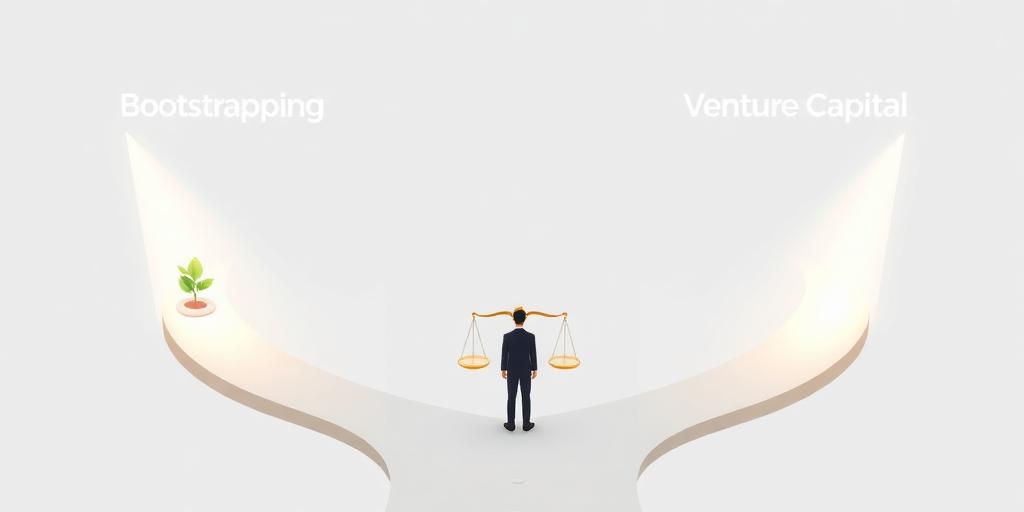The journey of building a startup is often characterized by pivotal decisions, and few are as critical as determining how to fund your venture. Founders typically face a fundamental choice: to bootstrap, relying on internal resources and organic growth, or to pursue venture capital, inviting external investment for rapid expansion. Each path offers distinct advantages and challenges, and the optimal choice is rarely universal. This authoritative guide will delineate the core tenets of both bootstrapping and venture capital, enabling founders to make an informed decision aligned with their strategic vision and long-term aspirations.
Understanding Bootstrapping: The Path of Self-Reliance Bootstrapping involves funding a business purely through personal savings, revenue generated by the business itself, or minimal debt. It's a testament to self-reliance, demanding lean operations and resourcefulness. This approach prioritizes sustained profitability and often results in slower, more controlled growth, making it a viable startup funding strategy for many.
Advantages of Bootstrapping: Full Ownership and Control: Founders retain 100% equity and decision-making authority, free from external investor influence, a key benefit for self-funded business owners. Focus on Profitability: The necessity to generate revenue early instills a strong focus on sustainable business models and customer acquisition. Flexibility and Agility: Without investor reporting or specific growth mandates, founders can pivot and adapt quickly to market changes. Reduced Pressure: While self-imposed pressure exists, it often differs from the intense, rapid-growth expectations of VCs. Organic Growth: Builds a business on solid fundamentals, proving market viability before scaling.
Challenges of Bootstrapping: Slower Growth Potential: Limited capital can restrict hiring, marketing, and product development, slowing market penetration. Resource Constraints: Founders often wear multiple hats, leading to potential burnout and stretched resources. Limited Network and Expertise: Without external investors, access to industry networks and seasoned advisors may be more challenging to build. Risk Concentration: Personal finances are often heavily invested, concentrating financial risk on the founder.
Understanding Venture Capital: Fueling Rapid Expansion Venture capital (VC) involves external investors providing capital to startups with high growth potential, in exchange for equity. VC firms typically invest in companies they believe can achieve significant market disruption and generate substantial returns within a specific timeframe, often through an acquisition or IPO. This often dictates when to seek venture capital.
Advantages of Venture Capital: Rapid Scaling: Significant capital infusion enables aggressive hiring, marketing campaigns, and accelerated product development. Strategic Expertise and Network: VCs bring invaluable industry knowledge, mentorship, and extensive networks that can open doors to partnerships and talent. Validation and Credibility: Securing VC funding can enhance a startup's reputation, attracting top talent and customers. Operational Support: Many VC firms offer hands-on support in areas like strategy, finance, and talent acquisition.
Challenges of Venture Capital: Dilution of Ownership and Control: Founders cede significant equity and often board seats, leading to a loss of control over strategic decisions, a critical aspect of equity dilution impact. High-Pressure Environment: VCs expect substantial returns, imposing immense pressure for rapid growth and aggressive targets. Exit Strategy Focus: The primary goal of VC is a profitable exit, which might not always align with the founder's long-term vision for the company. Complex Fundraising Process: Securing VC can be a time-consuming and arduous process, diverting focus from core business operations. Misalignment Risk: Disagreements with investors over strategy, vision, or operational execution can be detrimental.
Key Considerations for Your Choice The decision between bootstrapping and venture capital hinges on several critical factors, requiring a thorough self-assessment of your business model, personal objectives, and market dynamics when choosing startup financing.
Growth Trajectory and Market Potential: Bootstrapping: Suitable for businesses with steady, predictable revenue streams and a sustainable path to profitability without hyper-growth. Venture Capital: Essential for companies targeting massive, rapidly expanding markets where speed to scale is paramount and first-mover advantage is critical.
Ownership and Control: Bootstrapping: Ideal for founders who prioritize absolute control and long-term equity retention. Venture Capital: Requires a willingness to dilute ownership and share control for the opportunity of exponential growth and a larger pie overall.
Risk Tolerance: Bootstrapping: Often involves higher personal financial risk but lower external pressure. Venture Capital: Transfers some financial risk to investors but introduces performance pressure and potential loss of strategic autonomy.
Industry and Business Model: Bootstrapping: Works well for service-based businesses, consulting, niche SaaS products, or lifestyle businesses that can generate revenue early. Venture Capital: More common for tech startups, biotech, or hardware companies requiring significant R&D, infrastructure, and rapid market capture before profitability.
When Bootstrapping is Ideal Bootstrapping is often the superior choice for founders who: Wish to maintain full control and build a sustainable business at their own pace. Have a business model that can generate revenue relatively early with minimal upfront capital. Are building lifestyle businesses or niche products with a loyal customer base, rather than aiming for hyper-scale. Prefer to validate their product and market fit organically before considering external investment. Are in industries where the cost of entry and scaling is not astronomically high.
When Venture Capital is Ideal Conversely, venture capital is often the necessary catalyst for ventures that: Operate in highly competitive, rapidly evolving markets where speed is a competitive advantage. Require substantial capital for R&D, complex technology development, or extensive market penetration. Are aiming for a massive global impact or disruption, necessitating aggressive scaling. Benefit significantly from the strategic guidance, industry connections, and validation that VC firms provide. Have a clear, demonstrable path to a significant exit (e.g., acquisition by a larger company or IPO).
Conclusion The decision to bootstrap or seek venture capital is not merely a financial one; it is a strategic choice that defines a startup's trajectory, culture, and ultimate destiny. There is no universally 'correct' answer, but rather a choice that must be meticulously weighed against the founder's vision, the business model's inherent characteristics, and the prevailing market conditions. By thoroughly understanding the implications of each path, founders can strategically align their funding approach with their long-term objectives, laying a robust foundation for enduring success.









